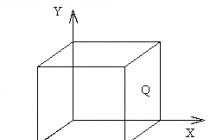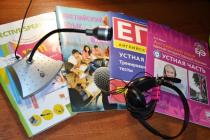In the Unified State Examination in English, task 2 asks you to look at an advertisement and ask five direct questions based on keywords and the proposed advertisement.
The format of the task is a conditional dialogue-questioning.
Preparation time – 1.5 minutes.
Time to complete the task – 1 minute
The maximum score is 5 points.
Each of the five task points will appear on the computer screen in turn. You will have only 20 seconds to construct one question.
Criteria for assessing task 2 on the Unified State Exam
The maximum number of points that can be obtained in a task is 2 - 5 points. Thus, if a task asks you to voice 5 questions, then each question is scored 1 point.
Note!
The time allotted for each question is enough to have time to correct the mistake. That is, if the examinee asked a question and realized that he had made a mistake, then he can manage to ask the same question correctly in the allotted time. Don't forget, one question is evaluated - the last one asked.
Typical mistakes in the English language exam in task 2 (USE)
- use mainly general and specific questions;
- use the simple present and simple future tenses of active and passive voice;
- In this task, the most important thing is to ask the question correctly, there is no need to invent something and remember complex vocabulary.
- observe intonation: a general question is pronounced with a rising intonation, and a special question with a falling intonation.
- ask indirect questions;
- ask several questions to the same point:
- do not forget the scheme of each type of question (do not confuse auxiliary questions, word order, etc., etc.)
Types of questions in English
The ability to ask questions is important when learning English. Accordingly, in order to complete this task with the highest score, the examinee must know all types of questions in the English language.
Note!
It is not recommended to ask a question starting with the words “Could you tell me...”, since you can mistakenly ask not a question, but a request. For example,
Could you tell me price? - this is a request (error!)
Could you tell me how many
Reminder!
Don't forget about intonation in interrogative sentences. Intonation should rise in a general question and fall in a special one.
Clichés for successfully passing task 2 in the oral part of the Unified State Examination in English
We offer several tables of the most frequently encountered questions (clichés and question templates on various topics). For yourself, you can choose the option that is most convenient for learning.
Option 1. Cliché for task 2 in the “Speaking” part of the English language








 31. Recommendations- recommendations.
31. Recommendations- recommendations.
Do you have any recommendations?
32.Services that they provide during the trip— the service they provide during the trip.
What services do you provide during the trip?
33. Tours that they have— Tours that are available.
How many tours do you have?
I really want to write about why the oral part of the Unified State Exam does not reflect the student’s real speaking skills, but I’ll restrain myself. Instead, we will discuss more pressing issues - what speaking on the Unified State Exam consists of and how to win it.
Oral tasks
The oral part of the Unified State Exam consists of 4 tasks:
- Reading text
- Dialogue-questioning with support
- Description of the photo
- Comparison of two photos
All this is allocated 15 minutes. For correct completion of all tasks you can receive 20 points.
The peculiarity of this part of the exam is that it is taken on the computer. You come to a specially equipped classroom and receive a disk with the program. You launch the program on your computer, put on your headset and follow the instructions on the screen. You can see how it will look on the exam in online simulators or. On the display you will see a timer that will help you track your response time.
If there are any difficulties with the program, the assistant who is present in the class will help you. After recording each task, the student will be able to listen to himself. Please note that if the answer was not recorded, or was recorded with strong interference, you must tell your assistant about it! If you do not do this, the incorrectly recorded answer will be assessed by an expert.
Reading text
Task 1 of the oral part of the exam is reading a text on popular science topics. The legend goes that you are preparing for a report in a foreign language and rehearsing it in front of a friend.
On preparation give 1.5 minutes for the task, and reading text 1.5 minutes are also allotted. The text is small, so it’s quite possible to complete it in this time.
Here is an example of such a task:
Evaluation criteria
You can get everything for this task 1 point, if “speech is easily perceived: there are no unreasonable pauses; phrasal stress and intonation contours, pronunciation of words without violations of the norm. No more than five phonetic errors are allowed, including one or two errors that distort the meaning.”
An error that distorts the meaning is considered to be:
- Substitution of sound, which leads to a change in the meaning of the word. For example, live is pronounced with a long vowel – leave, cut – like cart. Or put is pronounced with the vowel “a” in the middle, and science is pronounced with two consonants at the beginning.
- Incorrect pauses when reading text.
Simple phonetic errors include:
- Incorrect reading of sentences with enumeration (must have rising intonation)
- Incorrect intonation of affirmative sentences (must have a falling tone)
- Incorrect placement of logical stress (it should fall on words that carry the main meaning in the sentence - most likely it is a noun or verb)
- Incorrect pronunciation of sounds typical of the English language, substitution of their pronunciation with Russian sounds: [θ], [ð], [w], [h], [ŋ], [ɜ:]
- Absence of a “linking r” – that is, voicing the final r/re in the position before a vowel if the next word begins with a vowel (for example, where is..., there are...)
Preparation
In fact, getting the maximum of 1 point for the first task is not difficult.
How I practice reading aloud with my students:
- I select a text (I take texts to read from the Solutions textbooks at the Intermediate and Upper-Intermediate level - they are voiced there), and listen.
- We work together to sort out incomprehensible places.
- We are looking for a passage of suitable size.
- We look through it and mark semantic pauses with vertical lines - | .
- We emphasize words that carry meaning (we ignore all functional ones - articles, prepositions, pronouns, auxiliary verbs).
- We listen to the passage again and repeat after the speaker, then the student reads it himself.
Then I assign the same algorithm to homework and listen to the student in class. Below is an example of text parsed this way:
I have already written about the reading rules that I pay attention to when preparing in, and. These are articles about the OGE, the first task in both exams is very similar. You will also find exercises for the sounds you have learned through the links.
- Practice at home with a voice recorder, listen to yourself and mark your mistakes. Since during the exam you will encounter noise interference in the form of other students who will start talking along with you and will irritate you, I advise you to turn on the TV or radio during training to imitate this same irritant.
- If you don’t know how to read a word (for example, shallow), remember how similar words are read (narrow) and read by analogy. When preparing, I strongly recommend checking the pronunciation of all difficult words with a dictionary
- Pause on punctuation marks and highlight independent parts of speech with intonation.
- Take your time! 90 seconds is enough to read the entire text at a calm pace
- If you realize that you read a word incorrectly, re-read it correctly. Only the last reading of the word will be counted.
- Before the oral part of the exam, speak one option at home in the morning
To prepare for this part of the exam, I, as always, recommend tasks from the FIPI website, as well as the following books: 
IN 2015 This year, for the first time, an oral part was introduced on the Unified State Examination in English. How to prepare for speaking and score the maximum number of points if there is so little time left before the exam? First, calm down and understand that this is a completely doable task. And secondly, familiarize yourself with the structure of this part of the exam and follow the tips mentioned below.
Let's prepare for the Unified State Exam together!
So, the oral part of the English language exam consists of 4 tasks.
Total response time for one examinee (including preparation time) - 15 minutes.
The maximum score for completing the oral part of the Unified State Examination in English is 20 points.
This is the computerized portion of the exam. Audio and video recordings are made during the response.
After completing all tasks, make sure that the audio recording of your answer is in high format (no noise interference, the sound level is sufficient for the examiner to perceive your answer). If the sound quality does not satisfy you - there is no sound completely or partially, or the recording is made very quietly, which makes it difficult to perceive - you should require a retake of the oral part exam!!!
The oral and written parts of the exam are held on different days according to the approved schedule.
The oral part of the Unified State Examination in English was not compulsory in 2015. And if the student decided not to take the speaking test, he automatically reduced the overall result by 20 points (100 - 20 = 80 points). My students passed the oral part in 2015 with a score of 19 and 16 points. I would like to note that the student received 16 points not because she did not have enough knowledge, but because the answer was too long and the recording time had expired. Therefore, while preparing for the exam, develop a sense of time!
Attention!
You can practice passing the oral part of the exam on a simulator by going to the website
Video instructions for completing Task 1 of the Oral Part of the Unified State Exam in English.
Exercise 1
- reading aloud a short text of a popular science nature.
Time to prepare - 1.5 minutes
Performance - 1.5 minutes
Maximum points – 1 point
What skill is being tested:
the phonetic side of speech (pronunciation of English sounds, intonation design of sentences) and reading technique (understanding the reading of vowels and consonants in the English language).
Evaluation criteria
1 point you will receive if your speech is easy to understand: there are no unnecessary pauses, phrasal stress and intonation contours are observed, words are pronounced without violating the norm: no more than five phonetic errors are allowed, including one or two errors that distort the meaning.
0 points will be received if the student's speech is difficult to understand due to a large number of unnatural pauses, hesitations, incorrect placement of stress and errors in the pronunciation of words OR more than five (5) phonetic errors are made that distort the meaning OR three or more phonetic errors are made that distort the meaning.
According to Unified State Exam experts, typical mistakes include:
- incorrect division into semantic syntagms of simple and complex sentences
- incorrect reading of syntagmas with enumeration (you need to read them with rising intonation)
- incorrect intonation of sentences with a falling tone
- incorrect pronunciation of unstressed syllables (lack of reduction)
- incorrect reading of words with long and short vowels, which affect the change in the lexical meaning of the word: least - list, leave - live, port - pot
- incorrect reading of words with voiceless and voiced consonants at the end of the word, which change the meaning of the word: ba d-ba t, foo d– foo t
- incorrect reading of words in which letters are written but not read: balle t, this t le, w hole, mus c les
- incorrect pronunciation of sounds typical of the English language, substitution of their pronunciation with Russian sounds: [θ] - [ð], [w], [h], [ŋ], [ɜ:]
Before you begin tasks 1 of the oral part of the Unified State Examination in English, I advise you to repeat “ ” and “ “.
Exercise 1
Imagine that you and a friend are preparing a school project. You have found interesting material for a presentation and want to read it to your friend. You have 1.5 minutes for preparation (reading silently) and 1.5 minutes to complete this task (reading aloud).
Example text
Madame Tussaud’s is the most popular wax museum in the world. There are life-size wax models of the famous and infamous, both living and dead. Among them are Elvis Presley, the Beatles, Michael Jackson, Marilyn Monroe, Charlie Chaplin, the British Royal family, Adolf Hitler, Jack the Ripper and many others.
The museum is located in Marylebone Road in London. There is usually a long queue in front of the museum. Many tourists consider their trip to London worthless without visiting this museum.
There are several halls at Madame Tussaud’s. Highlights include the Grand Hall, the Chamber of Horrors and “The Spirit of London” exhibition.
“The Spirit of London” is a new milestone for Madame Tussaud’s. It covers a period of more than 400 years of London history: from Elizabethan times to the present days. Sights, sounds and even smells combine to tell the colorful story of London to visitors.
Sample text
Task 1
Imagine that you are preparing a project with your friend. You have found some interesting material for the presentation and you want to read this text to your friend. You have 1.5 minutes to read the text silently, then be ready to read it out aloud. You will not have more than 1.5 minutes to read it.
Half the human beings who have ever died, perhaps as many as 45 billion people, have been killed by female mosquitoes. Mosquitoes carry more than a hundred potentially fatal diseases including malaria, yellow fever and elephantiasis. Even today, they kill one person every twelve seconds. Amazingly, nobody had any idea that mosquitoes were dangerous until the end of the nineteenth century. In 1877, the British doctor Sir Patrick Manson proved that yellow fever was caused by mosquito bites.
Seventeen years later it occurred to him that malaria might also be caused by mosquitoes. He encouraged his pupil Ronald Ross to test the hypothesis. Ross was the first person to show how female mosquitoes transmit the parasite. Manson went one better. To show that the theory worked for humans, he infected his own son – using mosquitoes carried in the diplomatic bag from Rome.
Advice: check the correct pronunciation of words in a dictionary malaria, elephantiasis, hypothesis, parasite
Listen to the audio recording of this text.
P.S. For reading, you can use texts from the training tasks for the Unified State Exam, section “Grammar and Vocabulary”, having previously completed them and checked them using the keys to avoid mistakes.
Sample text
Task 1
When it comes to California summer camps for kids, Skylake Yosemite Summer Camp is the very best. This year the camp is celebrating its 66th season.
If you are looking for a summer camp your kids will love, we invite you to consider Skylake. We are located in the California Sierra National Forest, on Bass Lake, just a few miles from the south gates of Yosemite National Park. Skylake Yosemite is the kind of summer camp kids love.
Our dock on Bass Lake offers a variety of fun-packed waterfront activities, including warm-water swimming, waterskiing and tubing, canoes and kayaks. All staff members are First Aid Certified and have Water Safety Certifications.
Getting to camp is easy, because we offer charter bus service from Northern and Southern California and provide complimentary pick up at the Fresno Yosemite International Airport, located only one hour from camp.
Audio: Adobe Flash Player (version 9 or higher) is required to play this audio. Download latest version. In addition, JavaScript must be enabled in your browser.
Sample text
Task 1
Imagine that you are preparing a project with your friend. You have found some interesting material for the presentation and you want to read this text to your friend. You have 1.5 minutes to read this text silently, then be ready to read it out aloud. You will not have more than 1.5 minutes to read it.
Some paintings found in different caves around the world are recognized as the work of Stone Age artists. But what was the purpose of the paintings? Why were they hidden in a dark room where there is no evidence that cave people lived?
No one really knows, but there is one theory that makes great sense. It is called the theory of Sympathetic Magic. According to this, the cave people believed that if they could make a likeness of an animal, they could put a spell over it. This spell would give the tribe power over the living animal.
Stone Age existence depends on killing animals — for food, clothing, and even weapons and tools. The animals were large and fierce; the cave people had only the most simple weapons. Hunters had to be brave and fearless. They needed more than a spear or club; they needed all the magic they could get. The magic could help the hunters catch the animals.
Listen to the audio recording of this text.
Audio: Adobe Flash Player (version 9 or higher) is required to play this audio. Download latest version. In addition, JavaScript must be enabled in your browser.
Sample text
Task 1
Imagine that you are preparing a project with your friend. You have found some interesting material for the presentation and you want to read this text to your friend. You have 1.5 minutes to read this text silently, then be ready to read it out aloud. You will not have more than 1.5 minutes to read it.
Mountain gorillas live in the dense forests of Central Africa and are one of man's closest relations in the animal kingdom. They live in family groups and spend the day eating plants. Every evening each gorilla builds a nest to sleep in.
Mountain gorillas are black, and have evolved very thick fur so that they can withstand the cold mountain air. An adult male is called a silver back because of the silver-gray fur that grows on its back when it reaches maturity. A silverback is about the same height as an average man but heavier. Females are much smaller.
The destruction of their natural habitat is a serious threat to gorillas. Illegal hunting and trading are also a problem. Tourism helps to finance the ongoing efforts to save this endangered species. A few companies organize gorilla safaris so that people can see these amazing creatures at first hand. Some of the money from these tours goes to wild life organizations to protect the gorillas.
Listen to the audio recording of this text.
Audio: Adobe Flash Player (version 9 or higher) is required to play this audio. Download latest version
Preparation for the OGE and the Unified State Exam
Secondary general education
Line UMK M.V. Verbitskaya. English language "Forward" (10-11) (basic)
Line of teaching materials of O. V. Afanasyeva, I. V. Mikheeva, K. M. Baranova. "Rainbow English" (10-11) (basic)
We analyze the Unified State Examination in English: oral part
We analyze the oral part of the exam with experienced teachers, build a reasoning, and select the optimal answer options.Jalolova Svetlana Anatolyevna, English teacher of the highest qualification category. Winner of the competitive selection for the Moscow Grant in the field of education in 2010. Senior expert of the State Examination Agency Unified State Exam in English. Winner of the All-Russian Olympiad of English Language Teachers “Profi-Kray” 2015. Certificate of honor from the Ministry of Education of the Russian Federation 2014, Certificate of winner of the competition for the best teachers of the Russian Federation 2007, Diploma of the winner of the competition for the Moscow Grant 2010. Work experience - 23 years.
Nedashkovskaya Natalya Mikhailovna, English teacher of the highest qualification category. Winner of the PNPO 2007. Winner of the competitive selection for the Moscow Grant in the field of education 2010. GIA OGE expert in English. Conducted a pedagogical examination of educational publications at the Russian Academy of Education 2015-2016. Certificate of Honor from the Ministry of Education of the Russian Federation 2013, Certificate of the winner of the competition for the best teachers of the Russian Federation 2007, Diploma of the winner of the competition for the Moscow Grant 2010. Work experience - 35 years.
Podvigina Marina Mikhailovna, English teacher of the highest qualification category. Winner of PNPO 2008. Winner of the competitive selection for the Moscow Grant in the field of education 2010. Senior expert of the State Examination Agency Unified State Exam in English. Conducted a pedagogical examination of educational publications at the Russian Academy of Education 2015-2016. Certificate of honor from the Ministry of Education of the Russian Federation 2015, Certificate of winner of the competition for the best teachers of the Russian Federation 2008, Diploma of the winner of the competition for the Moscow Grant 2010. Work experience - 23 years.
Trofimova Elena Anatolyevna, English teacher of the highest qualification category. Senior expert of the State Examination Agency Unified State Exam in English. Certificate of honor from the Ministry of Education of the Russian Federation in 2013. Work experience - 15 years.
Task 3. Description of the photo
Task 3. These are photos from your photo album. Choose one photo to describe to your friend
You will have to start speaking in 1.5 minutes and will speak for not more than 2 minutes (12–15 sentences). In your talk remember to speak about:
- where and when the photo was taken
- what/who is in the photo
- what is happening
- why you keep the photo in your album
- why you decided to show the picture to your friend
You have to talk continuously, starting with: “I’ve chosen photo number …”
Work program for the Enjoy English teaching and learning complex (basic level) for grades 10-11. Available for viewing and free download.
Methodical hintRead the assignment carefully and familiarize yourself with the presented plan. You have 1 minute 30 seconds to prepare for this task. It takes 2 minutes to complete it (that is, describe the photo). Select one of the photographs suggested for description. When choosing, be guided not by what kind of photo you like, but by how familiar you are with the topic and vocabulary on it, and how much you can describe in it. The choice should not take more than three seconds.
Important! The proposed plan does not indicate an introduction and conclusion, but they must be present, since you are asked to make a coherent, complete description of the photograph, which in itself presupposes the presence of an introductory and final part.
For the introduction and conclusion, as well as for answers to the first, fourth and fifth questions, you can prepare several templates in advance that can be easily and quickly modified depending on the photo. Thus, you can spend the bulk of the time (about a minute out of one and a half) allotted for preparation on describing the photo itself, that is, who and what is in the photo (second point of the plan) and what is happening in it (third point of the plan) . Some tips:
1. It’s always easier to talk about people you know, so imagine that the photographs are of your friends or relatives, determine what kind of family connections you have, and give the people names.
2. When describing the photograph itself, it would be advisable to divide it into parts and describe first what is in the background (in the background), then on the sides (on the left / right side), gradually moving towards the center or foreground (in the center of/in the foreground). Don't forget that if the photo was taken outside, you can always say a few words about the weather.
3. When describing the people in the photograph, you can say about their age and appearance, what they are wearing, what emotions they experience.
4. Next we describe what is happening in the photograph. For this we use the Present Continuous tense. Sometimes, for some reason, there is practically no action in the photo. It is necessary to mention this, explaining the reason. It is enough to name three actions.
The description of the photograph itself (that is, the answer to the second and third points of the plan) should take up approximately half of the total time, the second half should include the introduction and conclusion and the answer to points 1, 4, and 5 of the plan.
Important! Remember that this is not a story about what was happening in your life or in the lives of your relatives/friends at the time the photo was taken, but a description of what is happening in the photo.
Approximate completion of task 1
I"ve chosen photo number 1. (Introduction) You know, taking photos is my hobby, and I always take a lot of photos wherever I go. I keep the best photos in my family album. (Question 1 of the plan) I took this photo last summer in the forest near our country house when we had a family reunion. (Question 2 of the plan). In the photo you can see a group of children playing football (general information on the picture). The day is nice, it is sunny and not windy. In the background you can see a forest with tall trees and bushes and in the foreground there is green grass. There are some children in the center of the picture - they are all my relatives. They are all quite young. The oldest girl is 6. She is my sister Olga. She is at the front of the group. And the youngest one is my nephew Nikolay who is just behind Olga. They are all wearing light clothes-T-shirts and shorts as it is very warm. They all look very happy and excited as they are playing together. They are running after a ball trying to kick it. And you can see that Nikolay is very concentrated as he is moving very fast to be the first to catch the ball. (Please note that the entire description is in the present tenses - Present Simple (to describe statics) and Present Continuous (to describe movement)! (Answer to question 4) I keep this photo in my family album as it is very dear to me. It was actually a very memorable day when our big family got together and I could meet all my cousins and nephews and nieces and enjoy time together. (Answer to question 5 of the plan) I decided to show it to you as I"m proud of my family and happy that we get together from time to time and I wanted to share my emotions with you. Maybe next year you'll be happy to spend time together with us. (Conclusion) This is all I wanted to tell you about this photo. I hope you liked it.
#ADVERTISING_INSERT#
Task 4. Comparing two photographs, identifying commonalities and differences.
Task 4. Study the two photographs. In 1.5 minutes be ready to compare and contrast the photographs:
- give a brief description of the photos (action, location)
- say what the pictures have in common
- say in what way the pictures are different
- say which of the professions presented in the pictures you’d prefer
- explain why
You will speak for not more than 2 minutes (12–15 sentences). You have to talk continuously.
When performing this task, remember the following:
You have 1 minute 30 seconds to prepare for this task and 2 minutes to complete it.
Just like in the third task (description of a photograph), when completing task 4, you need to make an introduction and conclusion before you proceed directly to the answer according to the plan. The introduction consists of one or two sentences on the general topic revealed in the photographs (the fourth paragraph of the plan can suggest the topic) and one sentence telling what you will do now. If the topic is not formulated in any way, one last sentence is enough. In conclusion, to summarize what has been said, we need to return to the topic again (one or two sentences).
In response to the first point of the plan, a very brief description of each photograph is sufficient. It is necessary to say for each picture what is happening and where. And you can add one general sentence about what is in the first and second photographs.
When we reveal the second and third points of the plan, we need to find two common features and two differences. Both common features and differences should be of a general nature. Point number 4 of the plan can help not only with the introduction, but also with significant common features and differences, because they are also related to the main theme of the photographs.
When answering the fourth point of the plan, it is enough to rearrange the word order of the phrase I"d prefer the ...... (Profession) presented in the picture number indicated in the plan....... You cannot say I"d prefer the picture number. ... because it does not correspond to the task. You cannot say “I"d prefer to be in the picture number...., since this is incorrect in meaning - we cannot be in the picture. In the fifth point of the plan, you need to justify your choice made before this with 2-3 detailed sentences (point 4).
Don’t forget that task 4 is structurally close to the essay format, so it is necessary to use linkers (conjunctive words) when listing common features and differences. For example, Firstly, /Secondly,..... Or To begin with, -Furthermore, (Moreover,....What is more....). In conclusion/To conclude....-in conclusion.
Before listing the general features, it is necessary to say that you will now talk about general features. For example, Both pictures have some features in common. Before moving on to the differences, this also needs to be mentioned. For example, however, there are some differences.
When comparing, phrases or verbs expressing assumptions will sound good. For example, they could be designers. They must be in the office. They seem to be teenagers. They look like young employees. ......
Differences should not repeat common features. With an approximate time schedule, the introduction and response to the first and second points of the plan should not take more than one minute.
Example of task 4
(In modern society there is a great variety of different professions. People try to choose one according to their taste and abilities. And these two pictures show this. - this part of the introduction need not be said) Now I"d like to compare and contrast these two photographs. In the first picture there is a young teacher explaining something to the pupils in front of her. They all are in the classroom. In the second photo there are two people who look like designers studying what might be a project in their office .Both pictures have some similarities. Firstly, the most striking common feature is that both pictures show people engaged in doing jobs. Secondly, people are interested in what they are doing. They look quite concentrated on their work. Nevertheless, both photos have some differences. To begin with, in the first picture we can see the profession which presupposes working with people - the teacher is teaching pupils on her own, other people are not included in the process. Whereas in the second picture there is a profession which involves doing the job with co-workers. Moreover, in the first picture the classroom is practically empty except for a blackboard and some desks while the second picture depicts an office with a lot of furniture, models and whiteboards. I would prefer the profession presented in picture number one as I think it is a very challenging but rewarding job. Besides I love working with people, especially children and I have always been good at teaching my friends and my younger sister"s friends some things. (In conclusion, choosing the right profession which will suit you in all aspects is a very hard task and we must think a lot and ask for advice before we make the correct choice. – in case of lack of time, this sentence can be omitted) That is all I wanted to tell you.














